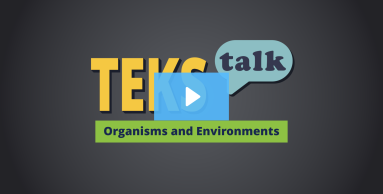- Science
- Grade 1
- Organisms and environments
Science.1.13.B
record observations of and describe basic life cycles of animals, including a bird, a mammal, and a fish; and

Knowledge and Skills Statement
Allow students to select or assign to students an organism that demonstrates a basic life cycle. Students will create a product such as a storybook or comic strip of the animal's life cycle. Students should include a picture and a description of how the organism looks and changes at each stage. Have students present their life cycle product to other students with different animals and have them discuss patterns observed when comparing the life cycles. Student products should demonstrate that they understand that, in a basic life cycle, organisms are born, grow bigger, and become adults. Features of the organism may become more distinct, but the organism does not change form. Student products may describe the stages in general terms like baby, chick, kitten, chicken, cat, or adult. Students are not expected to memorize all of the different names for babies of various animals.
The further explanation is designed to be a resource for educators that helps them better understand the topic their students are learning. Further explanations may be written at a more complex level than would be expected for students at the grade level.
In grade 1, students compare the life cycles of animals that resemble their parents, such as rabbits, chickens, or catfish. In grade 2, students will study animals that do not resemble their parents, such as butterflies, ladybugs, and frogs. In grade 3, students will be expected to compare animal and plant life cycles.
Research
Keeley, Page. “Formative Assessment Probes: Does It Have a Life Cycle?” Science and Children 48, no. 3 (2010): 26–28. http://www.jstor.org/stable/43175756.
Summary: Learning about life cycles can help students understand the continuity of life, but students need to know that life cycles look different depending on the organism. Many young students start learning about life cycles by observing and describing the parts of the life cycles of organisms that experience a complete metamorphosis, like butterflies. Learning life cycles through complete metamorphosis only can cause students misconceptions about life cycles. They can start to believe that only organisms that experience dramatic phase changes (like frogs or butterflies) experience life cycles rather than all living things. Collaborative discussion among students is essential in correcting these misconceptions. Teachers can discuss organisms using picture cards for younger grades, and students can decide together whether or not they think that organism experiences a life cycle and give their reasoning for why or why not. Students can then describe the different phases these organisms go through during their life cycle.
